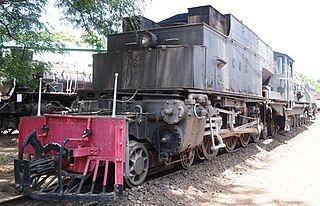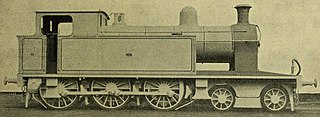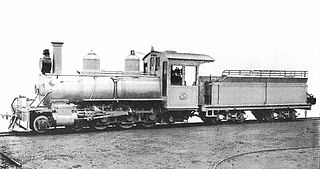
Under the Whyte notation for the classification of steam locomotives, a 2-10-4 locomotive has two leading wheels on one axle, usually in a Bissel truck, ten coupled driving wheels on five axles, and four trailing wheels on two axles, usually in a bogie. These were referred to as the Texas type in most of the United States, the Colorado type on the Burlington Route, and the Selkirk type in Canada.

A 2-8-8-4 steam locomotive, under the Whyte notation, has two leading wheels, two sets of eight driving wheels, and a four-wheel trailing truck. The type was generally named the Yellowstone, a name given it by the first owner, the Northern Pacific Railway, whose lines ran near Yellowstone National Park. Seventy-two Yellowstone-type locomotives were built for four U.S. railroads.

Under the Whyte notation for the classification of steam locomotives, 0-4-0 represents one of the simplest possible types, that with two axles and four coupled wheels, all of which are driven. The wheels on the earliest four-coupled locomotives were connected by a single gear wheel, but from 1825 the wheels were usually connected with coupling rods to form a single driven set.

A 4-6-0 steam locomotive, under the Whyte notation for the classification of steam locomotives by wheel arrangement, has four leading wheels on two axles in a leading bogie and six powered and coupled driving wheels on three axles with the absence of trailing wheels.
A wide variety of steam locomotives have been used on Ireland's railways. This page lists most if not all those that have been used in the Republic of Ireland and Northern Ireland. Irish railways generally followed British practice in locomotive design.

Under the Whyte notation for the classification of steam locomotives, a 2-6-4 locomotive has two leading wheels, six coupled driving wheels and four trailing wheels.

In the Whyte notation for the classification of steam locomotive wheel arrangement, an 0-4-4-0 is a locomotive with no leading wheels, two sets of four driving wheels, and no trailing wheels. The arrangement is chosen to give the articulation of a locomotive with only the short rigid wheelbase of an 0-4-0, but with its weight spread across eight wheels, and with all the weight carried on the driving wheels; effectively a flexible 0-8-0. Articulated examples were constructed as Mallet, Meyer, BMAG and Double Fairlie locomotives and also as geared locomotives such as Shay, Heisler, and Climax types. A similar configuration was used on some Garratt locomotives, but it is referred to as 0-4-0+0-4-0. In the electric and diesel eras, the Bo-Bo is comparable and closest to the Meyer arrangement of two swivelling bogies.

Cork, Bandon and South Coast Railway (CB&SCR), was an Irish gauge railway in Ireland. It opened in 1849 as the Cork and Bandon Railway (C&BR), changed its name to Cork Bandon and South Coast Railway in 1888 and became part of the Great Southern Railway (GSR) in 1924.
Under the Whyte notation for the classification of steam locomotives, 0-8-2 represents the wheel arrangement of no leading wheels, eight powered and coupled driving wheels on four axles, and two trailing wheels on one axle.

Under the Whyte notation for the classification of steam locomotives, 0-4-2 represents the wheel arrangement with no leading wheels, four powered and coupled driving wheels on two axles and two trailing wheels on one axle. While the first locomotives of this wheel arrangement were tender engines, the configuration was later often used for tank engines, which is noted by adding letter suffixes to the configuration, such as 0-4-2T for a conventional side-tank locomotive, 0-4-2ST for a saddle-tank locomotive, 0-4-2WT for a well-tank locomotive and 0-4-2RT for a rack-equipped tank locomotive.

Schull and Skibbereen Light Railway 1 and 3 were two 4-4-0T locomotives manufactured by Peckett and Sons in 1906 and 1914 respectively. They were the Schull and Skibbereen Railway's fifth and sixth locomotives, and took the numbers of withdrawn locomotives.
Cavan and Leitrim Railway 1 to 8 were 4-4-0T locomotives built by Robert Stephenson and Company, and were the first locomotives on the Cavan and Leitrim Railway (C&LR). On the 1925 amalgamation, when the railway became part of the Great Southern Railways, they were designated Class 1L or Class DN2.
Tralee and Dingle Light Railway 7 and 8 were two 2-6-0T locomotives manufactured by Kerr, Stuart and Company in 1902 and 1903 for the Tralee and Dingle Light Railway.

Under the Whyte notation for the classification of steam locomotives by wheel arrangement, the 4-8-4+4-8-4 is a Garratt locomotive. The wheel arrangement is effectively two 4-8-4 locomotives operating back to back, with the boiler and cab suspended between the two engine units. Each engine unit has two pairs of leading wheels in a leading bogie, followed by four coupled pairs of driving wheels and two pairs of trailing wheels in a trailing bogie.

The Schull and Skibbereen Railway was a minor narrow gauge railway in County Cork, Ireland. It opened in 1886 and closed in 1947. The track gauge was a 3 ft narrow gauge. The formal name of the company was The West Carberry Tramways and Light Railways Company Ltd.

The Cork and Muskerry Light Railway was a 3 ft narrow gauge railway in County Cork, Ireland. The first part of the railway opened in 1887 and closed in 1934. A major reason for building the railway was to exploit tourist traffic to Blarney Castle.

The CBSCR Bandon Tanks were a class of 4-6-0T mixed-traffic locomotives built for the Cork, Bandon & South Coast Railway (CB&SCR) between 1906 and 1920. The Bandon Tanks were the only 4–6–0 tank locomotives to be built by Beyer, Peacock & Company. The class went on to serve with the CB&SCR's successors: the Great Southern Railways from 1925 and CIÉ from 1945.

The South African Railways Class NG8 4-6-0 of 1904 was a narrow-gauge steam locomotive from the pre-Union era in the Cape of Good Hope.

The South African Railways Class NG G14 2-6-2+2-6-2 of 1931 was an articulated narrow gauge steam locomotive.
The Great Southern and Western Railway (GS&WR) Class 362, also known as class B3, consisted of six locomotives designed by Robert Coey and built between 1905 and 1907 for goods traffic and was the first tender locomotive to utilise the 4-6-0 wheel arrangement in Ireland.














